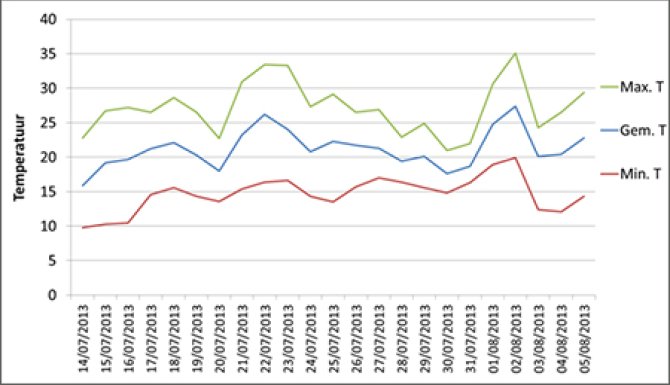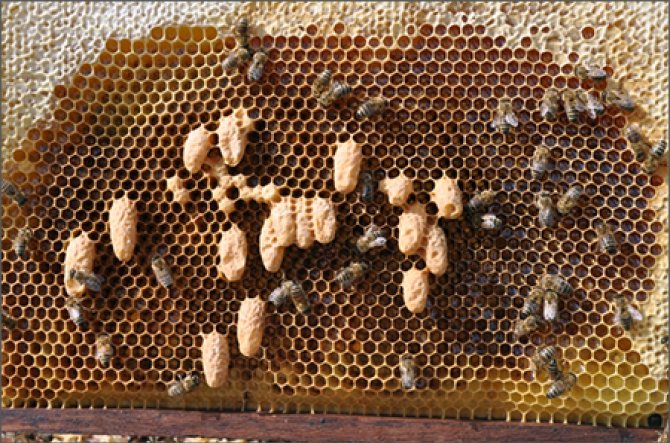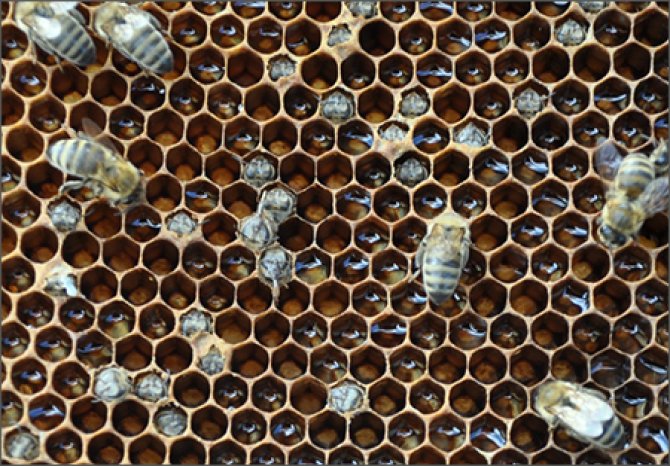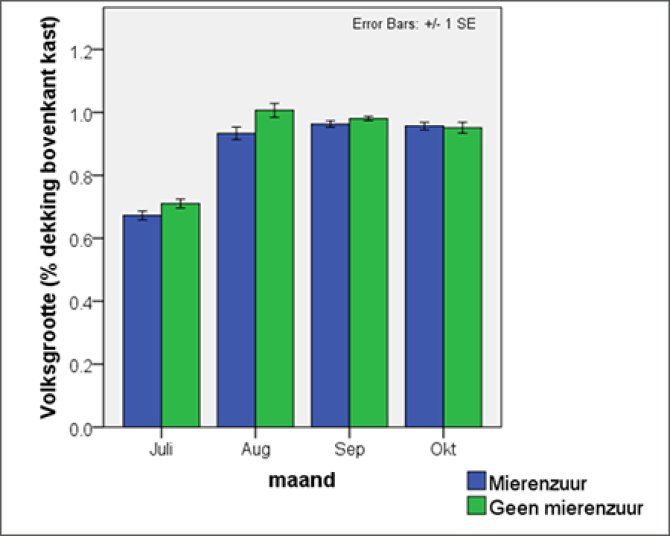
Bees@wur: Formic acid failure during summer experiment in 2013
Coby van Dooremalen and Bram Cornelissen
Formic acid treatment went wrong during research in summer 2013 despite taking care of the boundary conditions. An anecdote.
One of the main methods from our Dutch brochure ‘Effectieve bestrijding van Varroa’ is control of Varroa destuctor in bee colonies with formic acid in the summer (p38). This method we also wanted to apply during our study of ‘multifactorial causes of bee decline’ conducted for the Dutch Ministry of Economic Affairs in 2013/2014. Usually we prefer to use oxalic acid but in this experiment brood was present in the colonies at the time of Varroa control. We intended to apply once in July and once in August a formic acid treatment in the half of the experimental colonies (40 out of 80 colonies). The other half of the colonies was not controlled to provide high mite loads during the experiment.
Late July 2013 the preparations were made. The weather was monitored. It was very hot. Way too hot for a formic acid treatment according to the brochure instructions (temperature should be <30 ° C). The materials for the evaporation were collected, the vials filled. Outside the bee colonies flourished, foragers were highly active during the hot weather! The colonies overflowed with nectar.
July 29th was the day it was going to happen. Temperature had decreased from over 30°C to around 25°C and the forecast for the next few days was good. The colonies that were to be treated that day were equipped with a dispenser in the hive. On August 1st the mites were counted on the bottom boards of the hive and after which the bottom boards were removed due to the weather forecast that predicted again heat for on August 2nd (Figure 1 for temperature in that period).
I quote the log on August 1st , "bottom boards were removed due to heat tomorrow!

However, upon inspection of the colonies on August 2nd showed that the formic acid treatment had, despite our careful actions, harmed the colonies. Queens were dead or stopped egg laying, there were many queen cells on the worker brood area (Figure 2). Capped brood seemed dead (Figure 3). Strange things were going on, but it was clear that formic acid damaged our colonies.


In total, in 15 of the 40 colonies egg laying was interrupted and much of the brood was dead and cleared by the bees. On August 7th, new queens were successfully introduced in 5 of those 15 colonies. In the other 9 colonies the old queen had resumed laying. On August 12th, everything seemed back to normal: except for one queen, all queens were laying eggs. In that one colony the imported queen was not accepted well and another one was introduced instead (which was then introduced successfully).
All in all it was quite a scare! We thought we mastered that formic acid treatment rather well. Not only sad for the colonies, but it also gave difficulties for the experimental set-up. At that time we were measuring the 1 day old adult bees (greys) weekly. Many measurements had to be postponed. Yet still the colonies’ size did not seem to have suffered very much. On August (August 8th to be exact) the varroa controlled colonies (V-) were slightly smaller. Early September the colonies seemed to have similar size again compared to colonies that were not controlled (V +, and therefore had a lot of mites) (Figure 4).
After October colonies without mite control (V+) did however become smaller than V- colonies, but that's for a future article. We cannot exclude that the colonies with mite control could not have significantly been larger in August compared to the uncontrolled colonies. However, looking at the results of previous similar experiments, we saw no difference between colonies with high or low mite loads until after October.

Our brochure indicates that two treatments with formic acid need to be completed before September 1st. We were unsure whether our formic acid treatment had been very effective. The symptoms of the colonies gave us the impression that the formic acid evaporation happened extremely fast and furious. Because of the negative effects on the experiment during and after the first treatment, we dared not actually apply a second treatment, despite the maximum temperatures decreased to 20-25 ° C. Finally, we decided to resort to Apistan. The goal was to get the experimental mite populations as low as possible without major effects on the colonies. Apistan is suitable at least if there is no resistance to mites against the active compound. Because of the risk of resistance, we strongly advise and prefer the use of organic acids. Because we hardly ever use it, Apistan is also a great occasional last resort in our experiments. Vita Europe was so nice to supply us the amount Apistan strips free of charge to save our experiment. The Apistan strips have been in the colonies from August 22nd until October 16th.
In October, we determined the mite infestation in the colonies by counting how many mites per gram of bees we found. We found in the group without mite control on average 1.12 mites per gram of bees. In the group that was controlled, first with formic acid and then with Apistan, we found 0.03 mites per gram of bees: so over 40x less mites. One gram holds about 8 bees. Everything added together, at least the treatment had been effective.
But what happened exactly? Why did it go wrong and how?
What we think is that was the sum of all circumstances together, that tipped the balance the wrong way. In late July and early August it was beautiful weather and bees were gathering nectar in extremely high amounts, as can be seen in the picture in Figure 3. That nectar had to be thickened (evaporated) and bees have to ventilate to be able to do so. At the same time the colonies were growing fast: between the first week of July and the first week of August, the colonies increased in size from 7 to 10 frames of bees. On top of that, we harvest no honey from our colonies. They keep all. In early August the colonies were therefore very crowded with bees, brood and food. Closing off the bottom side of the hive with a board for evaporation of formic acid caused a change in the hive climate.
Our hypothesis is that the high growth rate of the colonies in combination with with large amounts of bees and food, decreased the maximum ambient temperature they could handle during formic acid evaporation. During the treatment, the average maximum temperature was 25°C. On the last day (August 1st) the temperature started to increase (up to 30°C). Therefore, the bottom boards were removed before the afternoon. In hind side, perhaps that was already too late. During the check up, we observed that the bees already had been unable to keep their nest temperature around their optimum temperature (homeostasis). When we read back in the field log (during evaluation ...) we already wrote before the treatment started that bee ‘beards’ were hanging out of the hives. That was perhaps a sign for risk of overheating ....
Looking back (thorough search) in the scientific literature we found an article (Satta et al 2005) which refers to high bee mortality in Mediterranean conditions, but the article did not speak of queens stopping egg laying or dead pupae. The evaporation rate of the formic acid in the dispensers was very high due to the high outdoor temperatures in their study. In earlier work by ourselves (Cornelissen and Gerritsen 2006), we also saw some mortality of workers after a formic acid treatment, but less so than with other treatments. Mari van Iersel warns (in the Monthly Beekeepers of June 2000) or for mortality and damage to bees at high temperatures, but says never to have experienced damage at temperatures up to 30°C. The violent reaction that we experienced with our colonies, we have never encountered before (EN or NL sources). On the contrary: Formic acid was stated to give no damage, except in areas with a temperate climate because there evaporation sometimes occurs to slow due too low ambient temperatures during summer. Too slow evaporation decreases the effectivity of the treatment and mite damage occurs.
What have we learned?
- That despite the damage, DOING something (albeit with some help from apistan) is better than doing NOTHING.
- That Varroa control is really very difficult with methods / techniques such as formic acid, even for experienced people. We ourselves are experienced, but we do not work with formic acid routinely. Possibly that already creates a certain margin for error.
- That the boundary conditions, that we determined still hold, but in rare cases not such as in colonies with large amounts of fresh nectar in combination with high temperatures.
- That we must read closely in our field log and also take our own warning signs that are not related to the described conditions for treatment into account in the decision making.